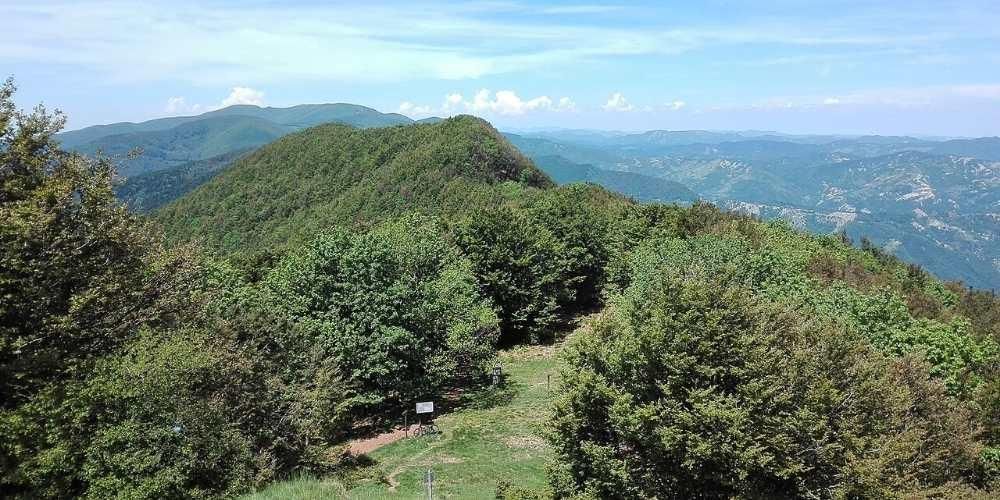In our journey through the UNESCO Sites of Italy, we will discover a destination quite different from the others. The Sasso Fratino Natural Reserve, a UNESCO World Heritage Site since 2017, is a place where trees have been writing history for a long time.
Beech trees have been born, live and die here for hundreds of years and are silent witnesses to an incredible journey through human history.
So let us share with you the secrets of the most resilient face of nature in the ancient beech forest of Sasso Fratino.

Where the Sasso Fratino Integral Nature Reserve is located, a UNESCO World Heritage Site since 2017
Nestled within the Casentino Forests, Monte Falterona and Campigna National Park, Sasso Fratino covers nearly 800 hectares in the province of Forlì Cesena, in the southern part of Emilia Romagna.
Two municipalities are involved, Bagno di Romagna and Santa Sofia, and the landscape is unquestionably that of the Apennines.
The exceptional nature of this incredible and ancient part of the world has ensured that the ancient beech forest is now protected not only by the National Park but also by UNESCO.
In this way, since 2017, Sasso Fratino has joined the more than 70 "Ancient primaeval beech forests of the Carpathians and other regions of Europe" recognized by UNESCO as a World Heritage Site. This is the 52nd UNESCO site for Italy.
Italy's splendid old-growth beech forest: the long history of a forest to be protected
If today this forest can still tell the story of its extraordinary value over the centuries, it is essentially for two reasons.
On the one hand, the decision to protect the land within the Casentino Forest National Park. On the other, perhaps more important, the immense difficulty of accessing the beech forest. The ruggedness and steepness of the terrain have protected the incredible beech forest from man's activities.
Indeed, we cannot refrain from telling you how much this beech forest has been exploited and all the territory included today in the Nature Park. The beginning of exploitation can be traced back to the late 14th century, when timber was in great demand for the shipyards of Livorno and Pisa, but also for the construction of churches and palaces in Florence.
The saving grace of the Sasso Fratino beech forest was that it was particularly inaccessible compared to other areas of the woods.
This situation of intensive and indiscriminate exploitation, first for timber, then for coal, continued until the early twentieth century when the forest became state-owned.
In 1959 the Sasso Fratino Integral Nature Reserve was finally created, and its territory was gradually extended over the years. They did such an excellent job of preserving the forest that in 1985 Sasso Fratino received the European Diploma for Nature Conservation.
What does the beech forest look like today?
The territory of the Reserve, where the beech trees are among the oldest in Europe
From the 1520-meter high Poggio Scali to the 650-meter high Ponte di Campo alla Sega, the reserve's territory is exceptionally rugged, with numerous ditches and slopes but also pretty flat areas.
Between streams and waterfalls, the area occupied by the beech forest stretches at most 6.6 km in length and about 2.2 in width.
The richness of the area consists of the majestic forest heritage: beech and white spruce, but also maple, elm, ash and various conifer species. Above 1300 meters, the forest gives way to a pure beech forest. Below 800 meters, on the other hand, in addition to beech trees, hazels, hornbeams, and ash trees.
The beech trees that inhabit this place are very long-lived, with some reaching close to 600 years. They protect a terrain conducive to countless mushroom species (about 800 mentioned!), but also numerous animal species. Deer, fallow deer, roe deer and even wolves, weasels, nocturnal raptors and pine martens live in the beech forest. Bears, however, have been extinct for several years.
How to visit the Sasso Fratino Natural Reserve, the old beech forest protected by UNESCO
If the mystery surrounding this forest stirs the spirits of enthusiasts to walk all the trails in Sasso Fratino, we must tell you that it is impossible.
The Sasso Fratino Reserve can only be visited through special study permits. It is certainly possible, however, to walk the entire area around the reserve through the many trails offered by the Casentino Forest Park.
Such an extraordinary territory, guardian of the memories of our past, deserves to be protected at all costs.
About the author
Written on 12/01/2023




Elisa Borgato
The Sasso Fratino Nature Reserve in southern Emilia Romagna is home to an ancient UNESCO Heritage beech forest. Let us discover it together.